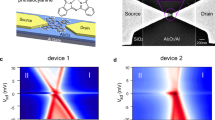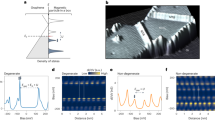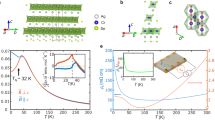Abstract
In the original discussion of the Kondo effect, the increase of the resistance in an alloy such as Cu0.998Fe0.002 at low temperature was explained by the antiferromagnetic coupling between a magnetic impurity and the spin of the host’s conduction electrons1. This coupling has since emerged as a very generic property of localized electronic states coupled to a continuum2,3,4,5,6,7. Recently, the possibility to design artificial magnetic impurities in nanoscale conductors has opened avenues to the study of this many-body phenomenon in a controlled way and, in particular, in out-of-equilibrium situations8,9,10. So far though, measurements have focused on the average current. Current fluctuations (noise) on the other hand are a sensitive probe that contains detailed information about electronic transport. Here, we report on noise measurements in artificial Kondo impurities realized in carbon-nanotube devices. We find a striking enhancement of the current noise within the Kondo resonance, in contradiction with simple non-interacting theories. Our findings provide a sensitive test bench for one of the most important many-body theories of condensed matter in out-of-equilibrium situations and shed light on the noise properties of highly conductive molecular devices.
This is a preview of subscription content, access via your institution
Access options
Subscribe to this journal
Receive 12 print issues and online access
$259.00 per year
only $21.58 per issue
Buy this article
- Purchase on SpringerLink
- Instant access to full article PDF
Prices may be subject to local taxes which are calculated during checkout




Similar content being viewed by others
References
Kondo, J. Resistance minimum in dilute magnetic alloys. Prog. Theor. Phys. 32, 37–49 (1964).
Madhavan, V., Chen, W., Jamneala, T., Crommie, M. F. & Wingreen, N. S. Tunneling into a single magnetic atom: Spectroscopic evidence of the Kondo resonance. Science 280, 567–569 (1998).
Li, J., Schneider, W.-D., Berndt, R. & Delley, B. Kondo scattering observed at a single magnetic impurity. Phys. Rev. Lett. 80, 2893–2896 (1998).
Goldhaber-Gordon, D. et al. Kondo effect in a single-electron transistor. Nature 391, 156–159 (1998).
Nygard, J., Cobden, D. H. & Lindelof, P. E. Kondo physics in carbon nanotubes. Nature 408, 342–346 (2000).
Park, J. Coulomb blockade and the Kondo effect in single-atom transistors. Nature 417, 722–725 (2002).
Liang, W., Shores, M. P., Bockrath, M., Long, J. R. & Park, H. Kondo resonance in a single-molecule transistor. Nature 417, 725–729 (2002).
De franceschi, S. Kondo effect out of equilibrium in a mesoscopic device. Phys. Rev. Lett. 89, 156801 (2002).
Paaske, J., Rosch, A. & Wölfle, P. Non-equilibrium singlet–triplet Kondo effect in carbon nanotubes. Nature Phys. 2, 460–464 (2006).
Grobis, M., Rau, I. G., Potok, R. M., Shtrikman, H. & Goldhaber-Gordon, D. Universal scaling in nonequilibrium transport through a single channel Kondo dot. Phys. Rev. Lett. 100, 246601 (2008).
Blanter, Ya. M. & Büttiker, M. Shot noise in mesoscopic conductors. Phys. Rep. 336, 1–166 (2000).
Zarchin, O., Zaffalon, M., Heiblum, M., Mahalu, D. & Umansky, V. Two-electron bunching in transport through a quantum dot induced by Kondo correlations. Phys. Rev. B 77, 241303 (2008).
Babic, B., Kontos, T. & Schönenberger, C. On the Kondo effect at half filling. Phys. Rev. B 70, 195408 (2004).
Jarillo-Herrero, P. et al. Orbital Kondo effect in carbon nanotubes. Nature 434, 484–488 (2005).
Makarovski, A., Liu, J. & Finkelstein, G. Evolution of transport regimes in carbon nanotube quantum dots. Phys. Rev. Lett. 99, 066801 (2007).
Herrmann, L. G. et al. Shot noise in Fabry–Perot interferometers based on carbon nanotubes. Phys. Rev. Lett. 99, 156804 (2007).
Lim, J. S., Choi, M.-S., Choi, M. Y., López, R. & Aguado, R. Kondo effects in carbon nanotubes: From SU(4) to SU(2) symmetry. Phys. Rev. B 74, 205119 (2006).
Le Hur, K., Simon, P. & Loss, D. Transport through a quantum dot with SU(4) Kondo entanglement. Phys. Rev. B 75, 035332 (2007).
Meir, Y. & Golub, A. Shot noise through a quantum dot in the Kondo regime. Phys. Rev. Lett. 88, 116802 (2002).
Gogolin, A. O. & Komnik, A. Full counting statistics for the Kondo dot in the unitary limit. Phys. Rev. Lett. 97, 016602 (2005).
Sela, E., Oreg, Y., von Oppen, F. & Koch, J. Fractional shot noise in the Kondo regime. Phys. Rev. Lett. 97, 086601 (2006).
Mora, C., Leyronas, X. & Regnault, N. Current noise through a Kondo quantum dot in a SU(N) Fermi liquid state. Phys. Rev. Lett. 100, 036604 (2008).
Vitushinsky, P., Clerk, A. A. & Le Hur, K. Effects of Fermi liquid interactions on the shot noise of an SU(N) Kondo quantum dot. Phys. Rev. Lett. 100, 036603 (2008).
Lopez, R. & Sanchez, D. Nonequilibrium spintronic transport through an artificial Kondo impurity: Conductance, magnetoresistance, and shot noise. Phys. Rev. Lett. 90, 116602 (2004).
Haldane, F. D. M. Scaling theory of the asymmetric Anderson model. Phys. Rev. Lett. 40, 416–419 (1978).
Sasaki, S., Amaha, S., Asakawa, N., Eto, M. & Tarucha, S. Enhanced Kondo effect via tuned orbital degeneracy in a spin 1/2 artificial atom. Phys. Rev. Lett. 93, 017205 (2004).
Lopez, R., Aguado, R. & Platero, G. Shot noise in strongly correlated double quantum dots. Phys. Rev. B 69, 235305 (2004).
Acknowledgements
We thank A. Cottet for a critical reading of the manuscript and K. Le Hur, P. Simon, L. Glazman and N. Regnault for illuminating discussions. This work is supported by the SRC (R11-2000-071) contract, the BK21 contract, the ANR-05-NANO-055 contract, the EU contract FP6-IST-021285-2 and by the C’Nano Ile de France contract SPINMOL.
Author information
Authors and Affiliations
Corresponding author
Supplementary information
Supplementary Information
Supplementary Informations (PDF 269 kb)
Rights and permissions
About this article
Cite this article
Delattre, T., Feuillet-Palma, C., Herrmann, L. et al. Noisy Kondo impurities. Nature Phys 5, 208–212 (2009). https://doi.org/10.1038/nphys1186
Received:
Accepted:
Published:
Issue date:
DOI: https://doi.org/10.1038/nphys1186
This article is cited by
-
Tunneling current and noise of entangled electrons in correlated double quantum dot
Scientific Reports (2021)
-
Quantum Noise in Carbon Nanotubes as a Probe of Correlations in the Kondo Regime
Journal of Low Temperature Physics (2020)
-
Electronic noise due to temperature differences in atomic-scale junctions
Nature (2018)
-
Universality of non-equilibrium fluctuations in strongly correlated quantum liquids
Nature Physics (2016)
-
Orbital two-channel Kondo effect in epitaxial ferromagnetic L10-MnAl films
Nature Communications (2016)



